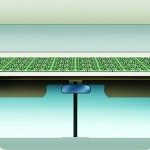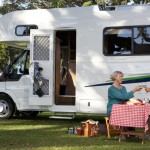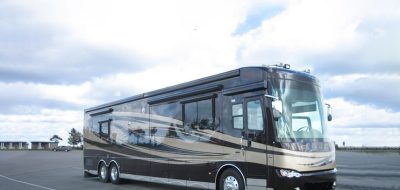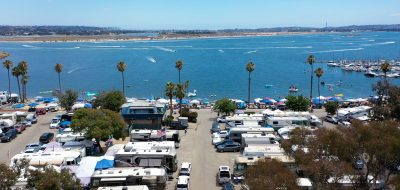 Hi, All! This month, we’ll talk about furnaces, 12V issues, tires, and slides. Have a great fall, and remember to submit your questions to [email protected].
Hi, All! This month, we’ll talk about furnaces, 12V issues, tires, and slides. Have a great fall, and remember to submit your questions to [email protected].
Mark:
I have a 2011 Montana. My heater turned on, ran for a short time then turned off. I thought I had ran out of propane so after filling my tanks, I tried the heater again. I can hear something clicking in the heater when I try to turn it on, but it will not start. I have heard I may have to replace the board in the heater any ideas would be appreciated. Mal
Hi, Mal
RV furnaces all work in pretty much the same fashion, so you can often get a good idea what’s wrong by paying close attention to what the furnace does when you try to turn it on. Let’s start by reviewing the sequence the furnace goes through when starting.
When we turn the furnace on, usually by setting the thermostat to ask for heat, the first thing that happens is the furnace receives a 12V signal from the thermostat, and the fan blower relay closes and the blower will start running. Normal airflow will cause a sail switch inside the furnace to close, sending power to the circuit board. The board will open the gas valve after about a 15-30 second delay, and the electronic igniter will begin to spark. If the flame lights, the board senses “flame lit” and the furnace will run and produce heat until the thermostat is satisfied. Furnace shutdown starts by the loss of the 12V signal from the thermostat. This removes power from the circuit board, closing the gas valve and extinguishing the flame. The blower relay (time delay) stays closed for about an additional minute before it opens, shutting the blower down.
The circuit board in the furnace monitors several things to ensure that everything is working properly. If anything happens to make the circuit board unhappy, the furnace enters lockout mode, which means the gas to the burner is shut off and the fan will run forever, or until you shut it off at the thermostat and try it all again.
Since this all happens in a sequence, we can make a fairly good guess on what the furnace is doing. I’m assuming from your message that when you turn your furnace on, nothing is happening: no blower running, and no heat. Since the blower relay closing is the first thing that happens, that’s a good place to start looking. Make sure power is getting to that relay, and that it is closing and sending 12V to the blower motor. If I mis-interpreted your question and what is actually happening is: the blower runs when you turn the furnace on, and you then hear the clicking of the spark igniter, but no heat is produced. In this case, we know the blower and sail switch are working, so the most likely problem is the flame is not lighting properly, or the board is failing to sense it. If the furnace tries to light the flame and does not sense the flame burning after a short time delay, it will enter lockout and not try again. Common causes of a failure to light are: No gas pressure at furnace inlet, gas is not flowing when the valve is energized, the igniter is dirty, damaged or disconnected, or the board is not sensing that the flame is lit, even if it is. If you are sure that propane is available at the furnace, then the problem is likely to be the gas valve, the igniter, or the circuit board. Other things can cause the furnace to fail, but these are the most common.
Since those circuit boards are fairly expensive, it is probably best to diagnose the furnace and determine what is actually wrong before you go much further. It may be something simple (and inexpensive). If you are not comfortable working on the furnace yourself, then it’s time to call in a tech. If you want to troubleshoot it yourself, here’s a good furnace troubleshooting guide: http://www.rvforum.net/miscfiles/Furnace_Trouble-2.pdf
————————————
Hi, Mark,
I have read many articles on tire pressure and heat but have never heard what temp is the max without doing damage to the tires. I have pressure and heat monitors on my fifth wheel and have seen temps as high as 105 degrees and wonder if this is too high when the ambient temp is 90. Thank you, Jerry
Hi, Jerry
Tire temperature while operating will generally rise a number of degrees above ambient temperature. This is caused by rolling resistance and friction, and is normal. How hot is too hot? I have seen my tires exceed 140 degrees on a really hot day. Bridgestone published the following info, which will give you an idea of what the “acceptable” range would be: “A very general rule of thumb is that a properly inflated/loaded tire, when up to operating temperature – one hour or more of operation – will typically run about 60 degrees F hotter than the ambient temperature. Anything above 200 degrees F could lead to tire degradation and you need to investigate for a problem.” Since a lot of factors play into this, my suggestion is: Buy an infrared handheld thermometer, and get in the habit of checking the tire and hub temperatures each time you stop during your travels. This will allow you to get a feel for what is typical on your RV. It’s not so much what the absolute temperature of a tire is, but that it is not diverging significantly from what you have established as “normal” for your RV. In other words, if you are used to seeing tire temps around 110 or 120 degrees, and you discover that one tire is running at 160 degrees, that’s your clue that something may be wrong, and you need to investigate further.
—————————————————-
Hello, Mark.
I have a 2014 Thor Four Winds 28Z motorhome. On my most recent trip I lost all electrical power to the house side on the motorhome while driving down the road. It is easy to notice as the radio loses power and when checking any of the house electrical items that should be working (lights, fridge, etc.) everything is out. Switching the batt cutoff has no effect as a matter of fact the normal click of the relay switching is not heard. Both time the problem corrected itself without me doing anything. While running on shore power everything seems okay so far. I have checked all the fuses/CB on the converter panel and they are all okay. Is there a breaker somewhere that I am missing? Any suggestion where to check would be greatly appreciated. Thanks, Andy
Hi, Andy
That is a classic symptom of a loose cable or connector somewhere in your house 12V system. Do a thorough inspection of all the connections in your battery bank, and check the connections at the 12V fuse box. Since you have a battery cutoff switch, check the connections on the big relay for that as well. It may require tracing the cables coming from the battery bank to find all of the connection points. If you can’t find anything loose, the problem may be the disconnect relay itself, but those don’t fail all that often. Loose connections or shorts in 12V wiring can be a serious fire risk, so if you can’t find a problem, you really should have a repair shop look at it.
—————————————-
Hi, Mark
We have a truck camper that we dry camp with a lot. It has 2-50 watt solar panels on it that put out 14+ volts, but how do I confirm that both panels are producing? (They don’t seem to charge the batteries much while we have it unloaded and are gone fishing for the day). Dave
Hi, Dave
The easiest way to test solar panels is with an ammeter. Most digital meters will measure 5-10 amps of DC current, so if you have a meter, you should be able to test them yourself. Disconnect the hot wire coming from the solar controller to the battery bank and use the ammeter to complete the circuit from that wire end to the battery terminal where it was attached. This will allow you to see the current coming from your panels. On a good sunny day with the panels in direct sunlight, I would expect to see around 5-6 amps of charge current. With the meter in place, you can cover or shade one panel at a time and see if the current drops to around ½ of what the two panels produce together. If you have a low reading, and covering one of the panels doesn’t seem to make a difference, then you’ve narrowed it down a bit, and can check the suspect panel for damage or loose/broken wires, etc.
——————————————
Hi, Mark
I have not seen this issue addressed anywhere. On a couple of occasions we have been set up in a campground and a storm has come up that included high winds. Both times we were setting broadside to the wind. We have rocked quite a bit in these conditions and wondered if we should pull in the slides. What is the best course of action when we have all 4 slides extended? Thank you, Ruth
Hi, Ruth
It‘s not so much a stability issue, more of a leak-prevention issue. The slides on your RV make a much better weather-resistant seal when they are retracted. When the slide is extended, strong wind can force air and water past the relatively soft inner seals and cause leaks inside. If it is really gusting and raining, retracting the slides is a good idea. This also helps protect your slide awnings from wind damage, if you have them on your RV.
——————————————
Founded in 1978, the Escapees RV Club provides a total support network for RVers that includes a wide variety of opportunities for fun, adventure, and education.
MAIL SERVICE The best mail–forwarding service in the country. Members can personalize their mail delivery receiving only the mail they want when they want. MAGAZINE Award-winning magazine written for RVers by RVers.
CHAPTERS There are 51 chapters across the U.S., Canada, and Mexico that offer local luncheons and rallies within 150 miles of home.
HOPs Theme–related outings and adventures held across the country.
ESCAPADES Five–day educational events that offer over 60 seminars and workshops to educate, entertain, and enhance the RV lifestyle.
PARKS Our discount park system offers a variety parking options. PLUS MUCH MORE!
A complete listing of all Escapees events and a comprehensive list of member benefits are found at www.escapees.









